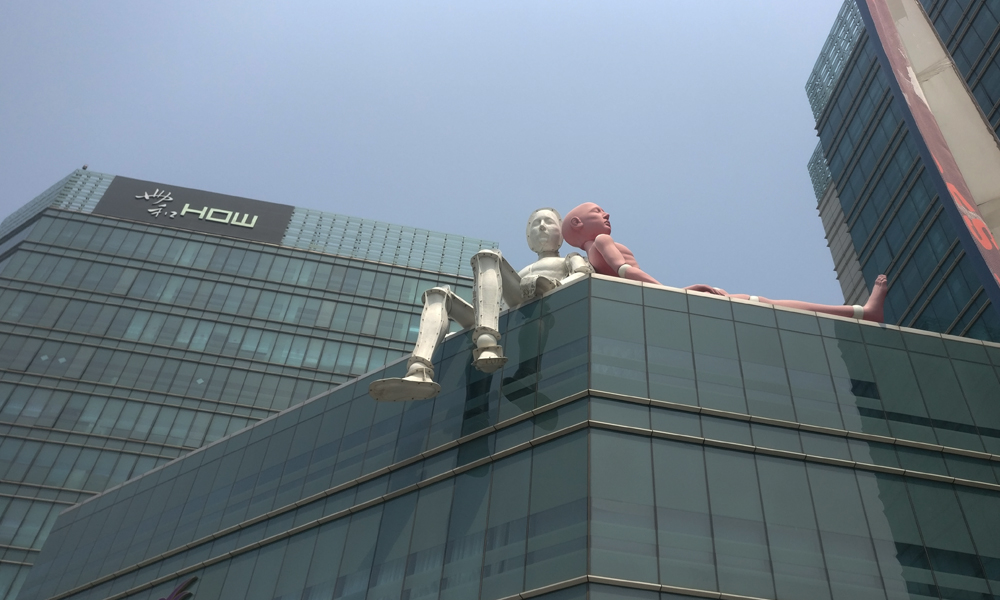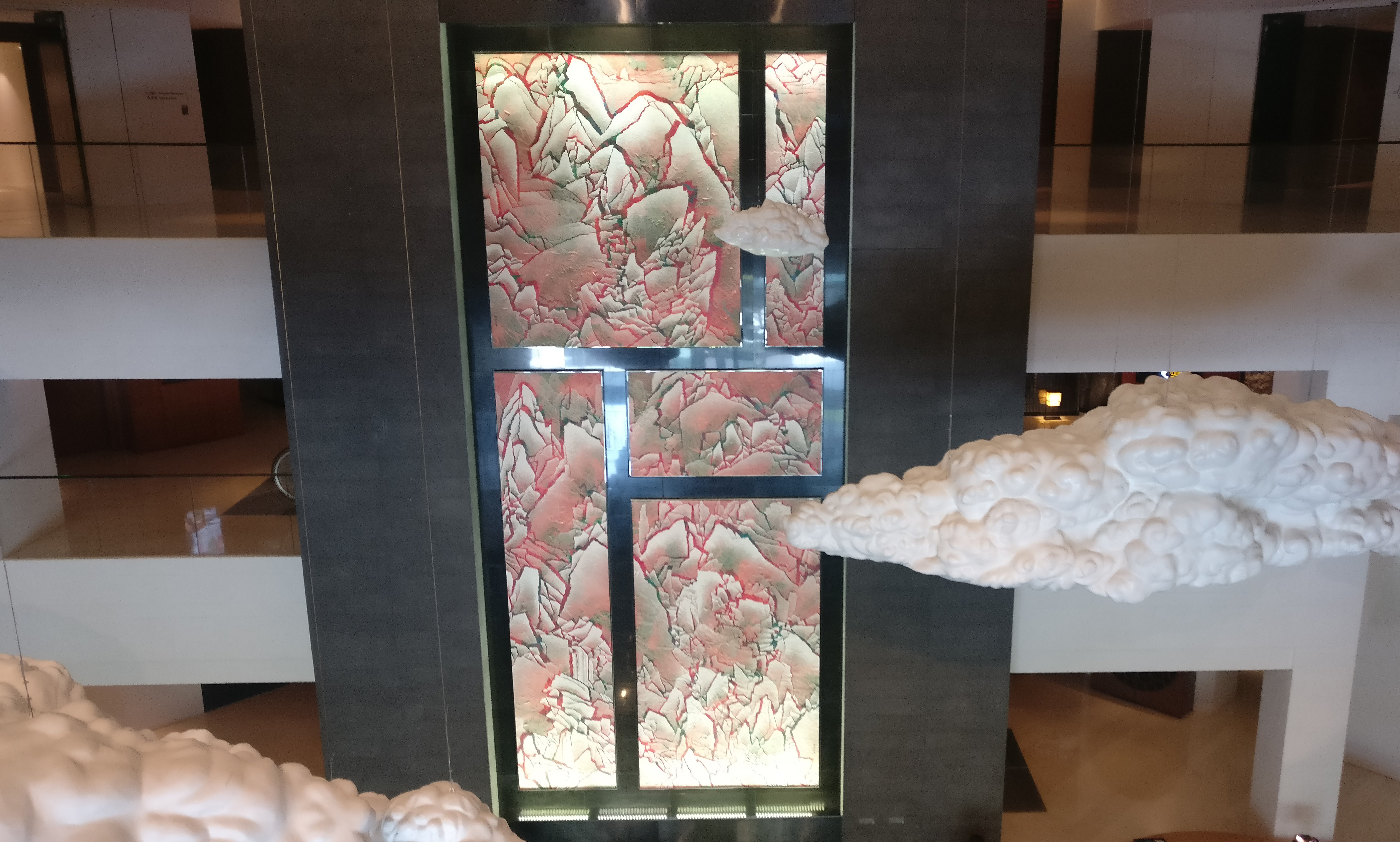During the latest China Residencies research trip to China, Kira was able to meet and interview Jade Ma, administrator of the HOW international Curatorial Residency at the HOW Art Museum in Shanghai, to learn more about this new residency program and the work done by the museum/hotel.
China Residencies: When did the museum and hotel open?
Jade Ma: The hotel opened in summer 2015, and the museum opened to the public last September.

HOW Art Museum façade
CR: Oh it’s brand new, just seven months old.
JM: Yes, the first exhibition was Julian Rosefeldt's solo show, including his recent and widely known film installation Manifesto. The current exhibition we have now is Lettres du Voyant: Joseph Beuys × Nam June Paik, which was supposed to be the inaugural one. However, given the tension between Seoul and Beijing, we decided to postpone it.
CR: Is everything OK now?
JM: It's OK. There was no official "no", but we wanted everything well-prepared.
CR: Who are the founders?
JM: Zheng Hao, who is also the owner of the hotel. He is a collector. Works from his collection are displayed everywhere in the hotel.
[in the hallways]
CR: I love this, the digital blood bank.
JM: It's a project by Wu Juehui. He is a media artist, teaching at the School of Intermedia Art, China Academy of Art, and he is also the Art Director of UFO Media Lab, based in Hangzhou.
HOW Art Museum consists of 2 museums. Besides HOW Art Museum Shanghai, we have another one in Wenzhou, which is the first museum established by the founder. Wenzhou is his hometown. It can be regarded as an experimental space for the one in Shanghai.
CR: Are you from Shanghai originally, and did you study art here?
JM: My hometown is Hangzhou, very close to Shanghai. After I got my MA in Arts Admin from SAIC, I moved to New York and worked in both for-profit and non-profit sectors, and also co-initiated an affordable arts and design website with friends. Then I came back to China by the end of 2015 and started working here.
[in the swimming pool]
Here is the swimming pool, and there is also a piece of Chris Jordan’s work from the founder's collection.
CR: Does every room have artwork?
JM: Not yet, currently we have almost 30 of the hotel rooms with works in them. We have a Picasso room, an Andy Warhol room... Those kind of big names.
CR: And guests can choose which room based on the artwork?
JM: Yes.
CR: Is there a curator for the hotel? Who decides which art goes where?
JM: For the public space, our museum team regularly discusses with the founder, but he is the person who chooses what goes into the rooms.
CR: There are very few residency for curators, so it's great.
JM: It's an important idea from the museum director Yun Cheagab. He thinks it's important to evoke cooperation potentials: we invite curators, scholars and writers to come to Shanghai, to work with us, and to explore the art scene here together, it will be very interesting.
[in the japanese restaurant]
This is Gu Wenda's work, combined elements of different Chinese characters to create his own. The characters here are “fake,” but still easy for us to recognize the original ones. Here, we use these invented characters to name each room of the restaurant.

Gu Wenda's invented character
[in the hotel lobby]
Here, we can see 2 commissioned works. This very large piece, which goes from the 1st floor to the 3rd floor, is Qiu Deshu’s Crack Landscape (Liebian Shanshui) and the Cai Zhisong Floating Clouds, both fitting perfectly with the space.

CR: That's funny, Cai Zhisong’s studio is right across from Red Gate Residency, and Katrin Hornek, an artist-in-residence once found one of his works in a field, and she placed a plaque there creating a new work, Venice Clouds.
[in the Chinese restaurant]
The subject of all artworks displayed in the Chinese restaurant are related to mountains and stone. The colors of the interior design here are all red and white, because of this series by Sea-hyun Lee, Between the Red-Landscape. You can see over here the gift set we developed with artist Guo Jian, who has created several animal sculptures. HOW Design Center, situated on the 3rd floor of our museum cooperated with him to make a set of products of dog sculpture. HOW Design Center has an exhibition space, a store, and it’s also an innovative platform where design exhibition, commercial sectors, brand integration and cross-border cooperation meet together.
Guo Jian dog sculpture gift sets
CR: What’s the neighborhood here like?
JM: This area is the Zhangjiang high-tech innovation zone, so there are lots of tech and software companies nearby, as well as affordable housing for those with university diplomas.
CR: How many artworks are on display?
JM: There are nearly 500 artworks on display, and we change works seasonally because the hotel owner would like to show as many as possible.
[In the VIP Lounge]
Now we are entering the HOW Art Club, VIP lounge for hotel guests and for meetings. Outside, in the public space of the hotel, what we saw was mostly contemporary art, but inside the lounge we’ll find antiques. The museum founder started his collecting “career” from antiques, most cloisonné, ceramics and silver pieces displayed here are from the late Ming Dynasty to the early Qing Dynasty. And all the mosaics on the ceiling and the pattern on the carpet are motifs from the cloisonné vases, traditional Chinese patterns.
CR: How many people on staff are on the art team? And at the residency?
JM: It’s not that easy to separate between teams: for the art part, around 12. Actually, we have a very large team covering art, design, technology, and we all support each other. The residency is just me, for now.
CR: And who’s on the jury?
JM: The residents will be chosen by the museum team.
CR: I know the open call just went out, so you haven’t had any curators-in-residence yet, but will they stay in the hotel?
JM: Yes, we provide housing in the hotel, we have a few rooms set aside. We won’t be covering the travel costs, because it’s a year-round project and it would be too expensive to fly everyone, but we are hoping to cooperate with institutions worldwide. We already decided on the first two curators, one from Germany who will arrive in the middle of May, and one from South Korea. We have very good cooperation relationships with the Goethe Institute as well as several cultural institutions in South Korea, like the Busan Cultural Foundation, so some of the curators coming from other countries will have the travel costs covered.
CR: How long are the residencies?
JM: One week to one month, it’s fairly short, but we don’t ask the curators to have a direct outcome for the program. For us, the idea is very simple, it’s more about potential cooperations, we will ask them to write a small essay and we’ll publish on our website and WeChat afterwards on whatever topic they would like. A public event, like a lecture, is required.
CR: And is there a stipend? Because often, the cultural institutions don’t have much funding either.
JM: No, we don’t have that budget, which is why we are looking for partners.
CR: If they are an independent curator or from a country with no public funding, how could they fund this?
JM: We already received a lot of applications from individual curators. That’s why we need to reach out to more partners.
CR: You could also perhaps partner with schools like NYU Shanghai who also often invite guest lecturers, so they would be here anyway and could stay longer. Otherwise, would you ever consider having a separate travel budget that people could apply for?
JM: Yes, that could be a solution.
CR: That would really change who can participate. We also just launched out open call for the residency director exchange with Japan, South Korea, Mongolia & China, which is happening in June, so that could be a potential way to meet partners in the region. How many curators will you be hosting?
JM: We decided to always have at least one person, and at most two at any given time, and will continue indefinitely.
CR: And who can apply?
JM: Anyone who is not already based in Shanghai. Emerging curators as well as mid-career curators are encouraged to apply. If they are already too established, it might be not that easy for us to cooperate as equals.
CR: How do you plan to work with the curators when they are here?
JM: We’d love to have someone who is highly interested in working on projects around Chinese contemporary art when they go back, and someone who wants to think of new ideas for our programs and to cooperate with our curatorial team here. We will assist with arranging studio and museum visits, and welcome presentations about their work or institutions.
CR: Will the talks be public or private?
JM: It could be a public lecture through our education department, if they’d like, especially if it lines up with our current exhibitions.
CR: One week is fairly short, especially for people who have never been to Shanghai — the museums here are so far apart, it’s hard to see more than one or two in a day!
JM: Yes, that’s why we’re working to create itineraries based on each curator’s interest in advance, so we can make suggestions and recommendations.
CR: Many of the other residencies in the network also support curators and researchers, so if they would like to stay longer, they might be able to go on to Beijing or Chengdu or somewhere else in China after.
JM: Yes, it’s great to have these kinds of connections, that would make this a much richer program.
CR: How far in advance do people need to apply? And when do people hear back?
JM: At least one month in advance, if they need to apply for a visa. We are doing several rounds of selection, so we’re still looking through the applications we received so far.
CR: And if the curators want to organise events or shows, is there space for them to do so?
JM: Yes, there’s a small space in the bar of the hotel, it’s a temporary exhibition space where we can show different kinds of work. There will be a lot of potential chances to work in the hotel, and in the future, there might be a space available in the museum. We’re also planning a sculpture park.
CR: Not all curators work with objects, what about those that work in communities, education, or writers?
JM: Of course, we are very open. We are currently paying more attention on education, and interested in developing public programs.
CR: How many curators are on staff at the museum?
JM: Besides our director, there are four curators on the team. We are also thinking of bringing on interns who study arts administration, curation, or art history to join us.
CR: Great, looks like you’re in a pretty good starting place - looking forward to interviewing some of the first curators-in-residence!
This interview was carried out by Kira Simon-Kennedy in May 2018
